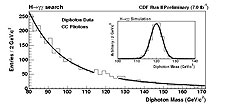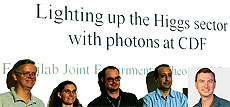Lighting up the Higgs sector with photons at CDF
 |
| The outer figure shows the diphoton mass distribution from the CDF data as well as the fit to the data that is used to estimate the background in the search window. The inner figure shows the shape of the Higgs boson signal that physicists expect to see. The main idea is that if the Higgs boson was produced at a large enough rate in the detector, it would be visible as a narrow bump in this distribution.
|
In order to explain how elementary particles acquire mass, the Standard Model of particle physics predicts the existence of the Higgs boson - the only particle in the theory that physicists have not yet observed experimentally.
Physicists detect the Higgs indirectly because they expect it to decay into other particles in a tiny fraction of a second. For this result, CDF scientists considered a case where the Higgs decays into two photons, the particle version of light. A major challenge of such a search is that the probability of this occurring is very low – physicists expect only about two out of every 1,000 Higgs particles produced decay to photons.
Searching for the Higgs by identifying two photons is an appealing approach, however, because two photons produce a cleaner signature in the detector
than typical Higgs boson decays, which produce sprays of particles in the detector like water from a hose. In contrast, photons leave compact and isolated clusters of energy. The clean signal in the detector makes it easier to reconstruct properties of the potential Higgs particle, such as its mass.
CDF scientists searched for a narrow mass bump in the diphoton data and shared their findings at a recent
May 20, 2011 Fermilab seminar. They found no evidence for Higgs particles in the data.
These results prove that the Higgs boson isn't produced more often than a certain value in the Tevatron collisions, or the scientists would have seen it. These limits on the Higgs production rate are not as sensitive as the ones stemming from searches using the more probable Higgs decays, but they contribute to the overall Higgs search at the Tevatron. Additionally, the LHC is betting on this channel for a low-mass Higgs observation, so techniques developed at the Tevatron will likely be useful there (more information).
Some theories predict a much higher rate for the Higgs boson decay into photons. CDF scientists also interpreted their data for one such model.
In light of this model they again found no sign of the Higgs boson, but exclude Higgs masses below 114 GeV/c2. This is a nice improvement from the previous CDF result discussed in a 2008 ROW article
and is currently the world's best limit on this type of Higgs particle.
— Edited by Andy Beretvas
 |
| These physicists were responsible for this analysis: From left: Ray Culbertson, Fermilab; Karen Bland, Baylor University; Craig Group, University of Virginia and Fermilab; Azeddine Kasmi, Baylor University; Jay Dittmann, Baylor University; and Jamie Ray, not shown, Stanford University. |
|